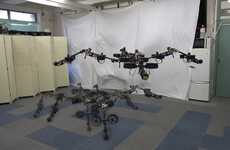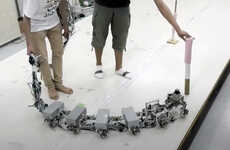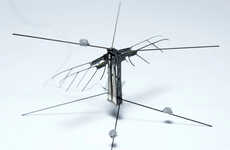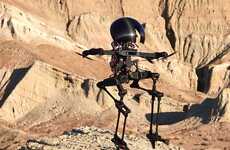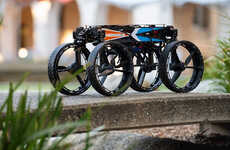
This Climbing Robot Was Developed At Stanford University
Rahul Kalvapalle — March 27, 2016 — Tech
References: bdml.stanford.edu & engadget
The Stickybot is a high-tech wall-climbing robot, developed by a talented team of engineers and researchers working out of Stanford University's famous Biomimetics and Dexterous Manipulation Lab, that is designed to take the university's acclaimed quadcopter technology to the next level.
This robot is able to stick to the wall for long periods of time without falling off, due to the fact that its climbing gear is located atop its rotor. This setup allows the robot to press its body against the surface for improved stability. The robot is also able to save a lot of energy which can go towards tasks such as capturing imagery or data, while the robot's mission time can be extended to as much as a couple of hours.
Ultimately, this climbing robot could have a lot of implications for the future development of climbing and perching robots that could be used in a variety of military and industrial contexts.
This robot is able to stick to the wall for long periods of time without falling off, due to the fact that its climbing gear is located atop its rotor. This setup allows the robot to press its body against the surface for improved stability. The robot is also able to save a lot of energy which can go towards tasks such as capturing imagery or data, while the robot's mission time can be extended to as much as a couple of hours.
Ultimately, this climbing robot could have a lot of implications for the future development of climbing and perching robots that could be used in a variety of military and industrial contexts.
Trend Themes
1. Climbing Robots - The development of climbing robots inspired by geckos presents opportunities for improved stability and extended mission times in various industries.
2. Biomimetic Robotics - The use of biomimetic principles in robotics, such as sticky wall-climbing capabilities, opens up possibilities for innovative applications in military and industrial contexts.
3. Energy-efficient Robotics - Efficiently designed climbing robots with energy-saving capabilities have the potential to enhance tasks like data capture in different sectors.
Industry Implications
1. Military - The development of climbing and perching robots can revolutionize military operations, offering improved surveillance and reconnaissance capabilities.
2. Industrial Automation - The implementation of climbing robots in industrial settings can optimize workflows by enabling robots to navigate vertical surfaces and perform specialized tasks.
3. Robotics Research - Advancements in climbing robot technology driven by biomimetic research present valuable opportunities for further exploration and innovation in the field of robotics.
5.8
Score
Popularity
Activity
Freshness


